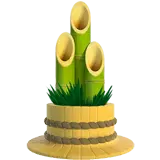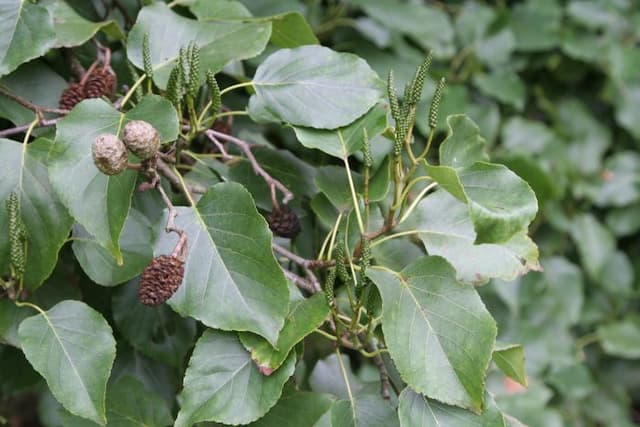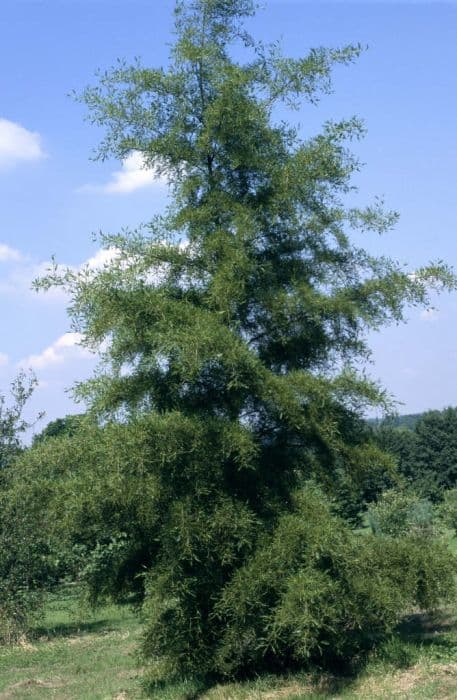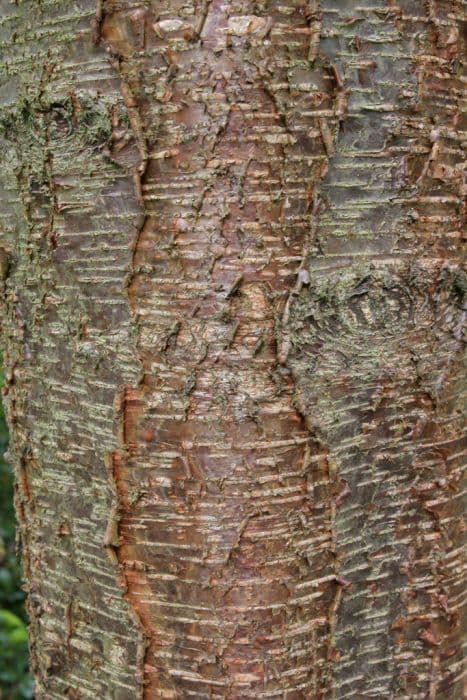Erman's Birch Betula ermanii 'Grayswood Hill'

ABOUT
Betula ermanii 'Grayswood Hill', commonly known as Erman's birch, is a deciduous tree that exhibits a multitude of visually captivating features. Its bark is particularly distinctive, showcasing a creamy-white hue that often peels in attractive sheets, creating an alluring texture and revealing subtle undertones of pink and orange. In the spring and summer, the foliage of this tree presents itself as a bright, cheerful green, and the leaves are shaped somewhat triangular with a pointed tip and a serrated margin, creating a soft, fine texture. When autumn arrives, the leaves transform into a spectacular display of yellow colors, adding seasonal interest to the landscape. The branches are adorned with catkins during the flowering period, which are long, cylindrical flower clusters that hang gracefully from the twigs. These catkins mature as the seasons change, adding another layer of textural contrast to the plant's overall aesthetic appeal. Overall, Erman's birch offers a sense of elegance and charm with its refined structure and captivating change of colors throughout the seasons.
About this plant
 Names
NamesFamily
Betulaceae
Synonyms
Erman's Birch, Gold Birch
Common names
Betula ermanii 'Grayswood Hill'.
 Toxicity
ToxicityTo humans
Erman's Birch, in general, is not known to be toxic to humans. There are no common reports of poisoning or adverse effects from ingesting any part of this plant. Therefore, typical contact with or ingestion of Erman's Birch should not cause any symptoms of poisoning in humans.
To pets
Erman's Birch is not considered toxic to pets. It is not associated with any significant toxicity for animals such as cats and dogs. Ingesting parts of this plant should not lead to symptoms of poisoning or result in adverse health consequences for pets. However, it is always prudent to prevent pets from consuming plants, as individual animals might have sensitivities or allergic reactions.
 Characteristics
CharacteristicsLife cycle
Perennials
Foliage type
Deciduous
Color of leaves
Green
Height
40 feet [12 meters]
Spread
30 feet [9 meters]
Plant type
Tree
Hardiness zones
5
Native area
Asia
Benefits
 General Benefits
General Benefits- Ornamental Value: Betula ermanii 'Grayswood Hill', commonly known as Erman's birch, features an attractive white peeling bark and a stately appearance, which makes it a hallmark for ornamental purposes in gardens and parks.
- Shade Provider: With its broad canopy, the Erman's birch offers considerable shade, making it suitable for planting in areas where sunlight moderation is desired.
- Habitat Support: The tree supports various wildlife, providing shelter and food for birds, squirrels, and insects.
- Seasonal Interest: Erman's birch has a year-round visual interest: bright green leaves in spring and summer, yellow autumn foliage, and striking bark in the winter.
- Soil Enrichment: As a deciduous tree, it sheds leaves that decompose to enrich the soil with organic matter, thus improving soil fertility and structure.
- Erosion Control: The extensive root system of Erman's birch can help stabilize the soil and prevent erosion, especially on slopes and banks.
 Medical Properties
Medical PropertiesThis plant is not used for medical purposes.
 Air-purifying Qualities
Air-purifying QualitiesThis plant is not specifically known for air purifying qualities.
 Other Uses
Other Uses- Woodworking – The wood of Betula ermanii 'Grayswood Hill' can be used in the crafting of small wooden objects or decorative items, taking advantage of its fine grain and workability.
- Culinary – Though not common, the sap of the tree may be used as a base for syrups and beverages similar to other birch species.
- Tanning – The bark of the tree contains tannins that can be used for tanning leather.
- Dye production – The bark and leaves can be used to produce a natural dye for coloring fabrics or crafting materials.
- Landscape design – The attractive bark and overall shape of the tree are used by landscape architects for visual interest and creating focal points in gardens.
- Literature and poetry - Birch trees, including Betula ermanii 'Grayswood Hill', have been celebrated for their beauty and used symbolically in various literary works.
- Photography – The distinct appearance of the tree, especially its bark, makes it a subject for nature photography and photographic art.
- Educational – The tree is used for educational purposes, helping students learn about botany, tree identification, and the ecological significance of birch species.
- Wood fuel – Like many trees, the wood of Betula ermanii 'Grayswood Hill' can be used as a source of firewood, although it is not the most calorific.
- Instruments – Small branches or pieces of the wood may be crafted into rustic musical instruments, owing to their resonance and pliability.
Interesting Facts
 Feng Shui
Feng ShuiThe Erman's Birch is not used in Feng Shui practice.
 Zodiac Sign Compitability
Zodiac Sign CompitabilityThe Erman's Birch is not used in astrology practice.
 Plant Symbolism
Plant Symbolism- Adaptability: Betula ermanii 'Grayswood Hill', commonly known as the Erman's Birch, often thrives in a wide range of soil types and climates, symbolizing the ability to adapt to various conditions.
- Purity: The white bark of the Erman's Birch is associated with purity and cleanliness, making it a symbol of new beginnings and fresh starts.
- Renewal: Birches are some of the first trees to colonize new or disturbed areas, so they're connected with growth and renewal.
- Hope: The presence of birch trees is often a sign that the land is recovering from damage, hence they represent hope and the promise of better things to come.
- Protection: In some cultures, birch trees are believed to ward off evil and negative energy, offering protection and safety.
- Youth: The graceful and slender form of the Erman's Birch, along with its association with renewal and growth, makes it a symbol of youth and vitality.
 Water
WaterThe Erman's birch requires consistent moisture, especially during dry spells. Water this tree deeply once a week, supplying about 10-15 gallons of water each time for a mature tree to ensure that moisture reaches the root zone. Adjust the watering frequency depending on rainfall, more during dry periods and less when it rains regularly. During the first growing season, it’s important to water more frequently, about 2-3 times per week, to establish a strong root system. In the winter, reduce watering since the tree will require less moisture. Always avoid waterlogging as this can lead to root rot.
 Light
LightErman's birch thrives in full sun to partial shade conditions. It performs best when it receives at least four to six hours of direct sunlight each day. A spot that is exposed to morning sun with some afternoon shade, or dappled sunlight throughout the day, would be ideal to protect it from the intense heat of the afternoon sun.
 Temperature
TemperatureErman's birch is hardy and can handle a temperature range roughly between -40°F to 80°F. The ideal temperature range for thriving growth would be between 50°F and 70°F. Ensure that the planting site is well-draining and protected from harsh winter winds to prevent frost damage to the tree.
 Pruning
PruningPrune Erman's birch to remove any dead or damaged branches and to maintain its shape or control its size. The best time for pruning is in late winter or early spring before new growth starts. Pruning is typically needed once a year, but inspect the tree periodically for broken or diseased limbs that should be removed immediately to maintain the tree's health and appearance.
 Cleaning
CleaningAs needed
 Soil
SoilErman's birch prefers a well-draining soil mix rich in organic matter. A mixture of loam, peat, and sharp sand with a pH range of 5.5 to 6.5 is ideal for promoting healthy root development and good moisture retention while allowing excess water to drain away, which is crucial to prevent root rot.
 Repotting
RepottingErman's birch is typically not a container plant; it's a tree that's best planted in the ground. If it must be grown in a large container, young trees may require repotting every 2 to 3 years to accommodate root growth; mature trees should be planted out or can be left undisturbed for longer periods.
 Humidity & Misting
Humidity & MistingErman's birch thrives in outdoor conditions with natural humidity and does not have specific humidity requirements when grown in its native or adaptable environments, as it's tolerant of a wide range of humidity levels typically found outdoors.
 Suitable locations
Suitable locationsIndoor
Not ideal for indoor growth due to size.
Outdoor
Plant in well-draining soil, full sun to partial shade.
Hardiness zone
4-7 USDA
 Life cycle
Life cycleThe life of Betula ermanii 'Grayswood Hill', commonly known as Erman's birch, begins with seed germination, which usually occurs in spring under adequate moisture and light conditions. The seedling stage follows, where the plants establish their root system and begin to develop their first leaves and stem structure. As the sapling grows, it enters the juvenile phase, characterized by rapid growth and development into a young tree with the development of characteristic white, peeling bark. The tree reaches maturity after several years, and during this reproductive stage, it produces catkins that facilitate wind pollination, leading to seed production and dispersal. In the mature stage, the Erman's birch can live for many decades, during which it undergoes periods of growth and dormancy, typically marked by seasonal changes. Eventually, as the tree ages, it enters the senescence phase, where growth slows, and it becomes more susceptible to environmental stresses, disease, and decay, leading to its natural death.
 Propogation
PropogationPropogation time
Late winter to early spring
The most popular method of propagating Betula ermanii 'Grayswood Hill', commonly known as the Erman's birch, is through seed. The best time for seed collection is late summer to autumn when the catkins are mature and releasing their seeds. To propagate by seed, collect the seeds and sow them in a well-drained seed-starting mix, covering them lightly with soil. Stratification, which involves chilling the seeds for a period to break dormancy, can enhance germination rates and is typically done by placing the seeds in a refrigerator for around 60 to 90 days (about 2 to 3 months). Once planted, seeds require consistent moisture to germinate, which can take several weeks to a few months. Seedlings can then be transplanted once they are large enough to handle.









